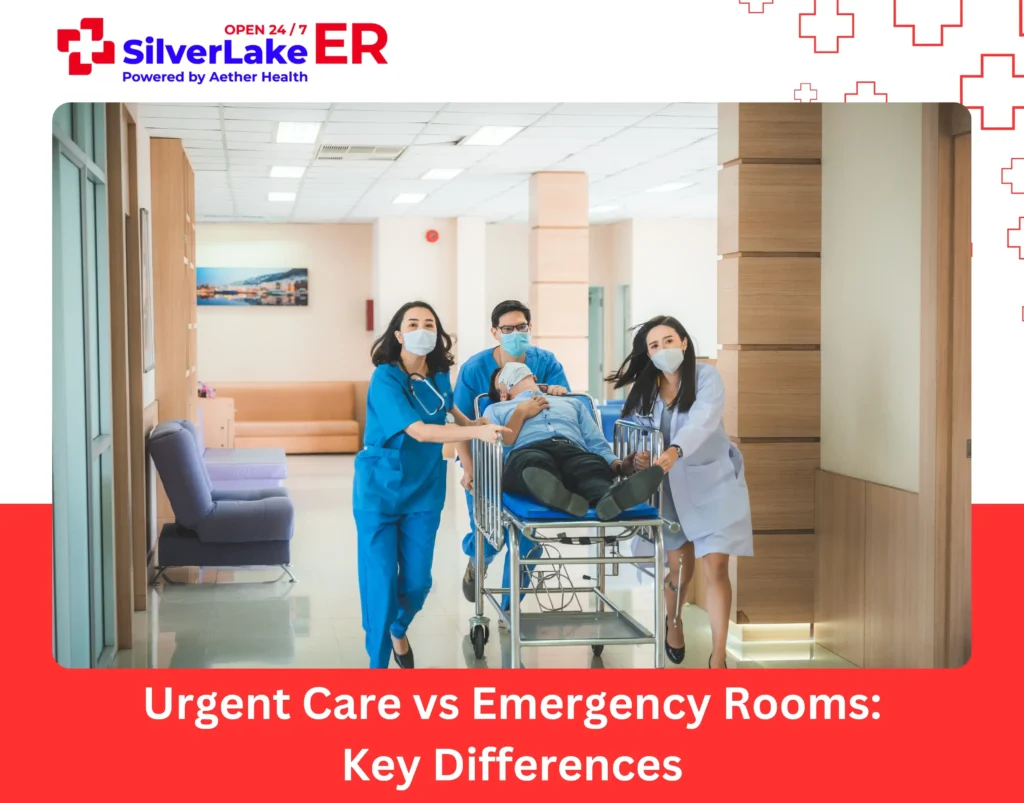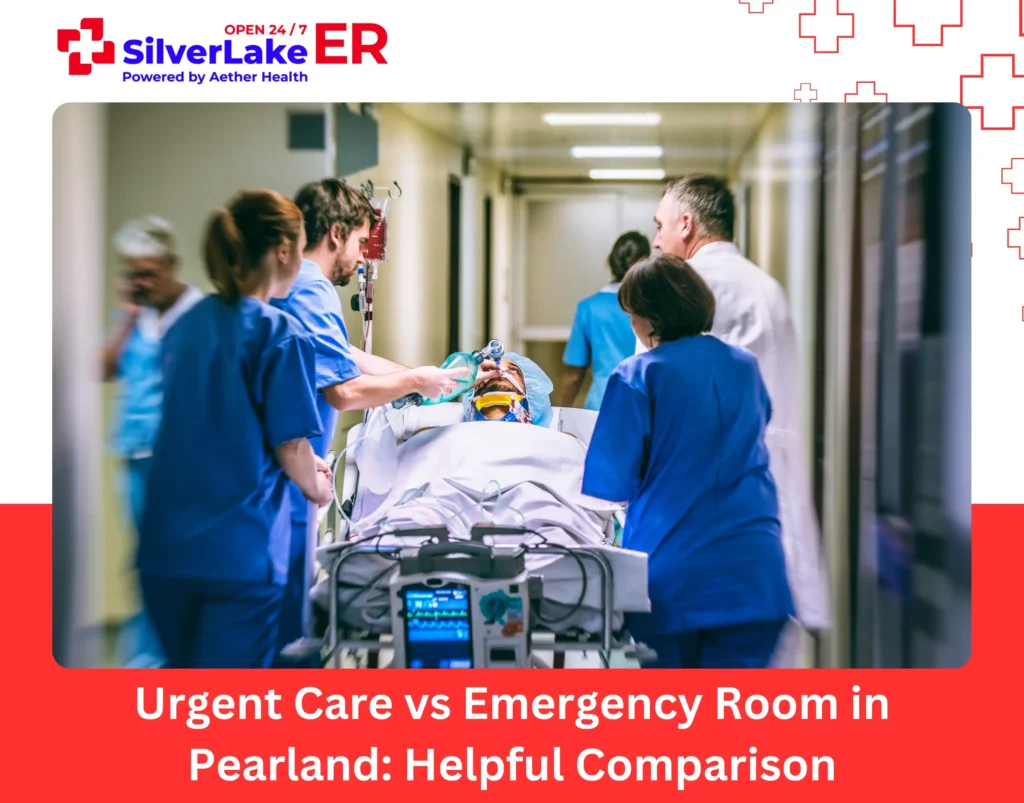Emergencies happen when we least expect them. When you’re in pain or dealing with a health scare, deciding between urgent care vs emergency room can add extra stress to an already difficult situation.
These two options serve different purposes, and knowing the difference is crucial for your health and peace of mind. This guide helps you understand when to visit urgent care versus the ER in Pearland, so you’re prepared to make the right choice in a medical emergency.
Understanding Urgent Care

Urgent care centers bridge the gap between your regular doctor and the emergency room. They treat non-life-threatening conditions and injuries that need same-day care but aren’t emergencies. These centers provide immediate medical attention without an appointment when your primary care physician isn’t available.
What Can Urgent Care Centers Treat?
These facilities are well-equipped to manage a variety of medical issues effectively, including:
- Mild allergic reactions: Providing quick relief to stop symptoms from worsening.
- Lacerations: Minor cuts needing stitches or wound care to avoid infection.
- Fever, flu, or cold symptoms: Conducting flu tests or treatments to alleviate discomfort and prevent complications.
- Sprains and minor fractures: Offering onsite X-rays and splinting services for faster recovery.
- Ear infections or sore throats: Delivering targeted treatments like antibiotics or ear irrigation.
- Mild Asthma: Quick relief for breathing difficulties that don’t require hospitalization.
- Nausea and Vomiting: Immediate care to prevent dehydration and identify underlying causes.
- Minor burns: Administering proper dressing and care to prevent scarring and infection.
These centers offer prompt care with shorter wait times, plus onsite services like X-rays and lab testing. However, for severe injuries or life-threatening symptoms, emergency care is always the right choice.
Understanding Emergency Rooms
Emergency rooms (ERs) provide immediate care for life-threatening and complex medical emergencies. Facilities like SilverLake ER in Pearland are designed to handle conditions that can quickly worsen without urgent intervention.
When Should You Visit an ER?
ERs are prepared to manage severe and time-sensitive conditions, including:
- Chest pain or heart attack symptoms: Quick diagnosis and interventions such as EKGs or cardiac catheterization can be lifesaving.
- Stroke symptoms: Timely treatment is essential to reduce brain damage. Watch for signs like sudden confusion, weakness, or trouble speaking.
- Severe head or spinal injuries: Emergency imaging and stabilization are crucial to prevent lasting damage.
- Difficulty breathing: Immediate airway management and oxygen support are necessary.
- High fevers: It’s important to address fever-related seizures in children or infections that could escalate quickly.
- Uncontrolled bleeding: Advanced techniques, including sutures and blood transfusions, are used to stop hemorrhaging.
- Major fractures or trauma: Immediate pain relief, X-rays, and surgical intervention may be required.
In emergencies, every second counts. ERs combine expertise, advanced diagnostic tools, and round-the-clock availability to handle critical health situations.
Urgent Care vs Emergency Rooms: Key Differences

When you need medical care in Pearland, understanding these key differences between urgent care and emergency room can help you choose the right facility.
Severity of Condition
- Urgent Care: Treats moderate health issues that need same-day care but aren’t life-threatening
- ER: Handles fatal emergencies that require immediate action
Cost
- Urgent Care: Lower costs for non-emergency medical care
- ER: Higher costs reflecting specialized care and advanced emergency capabilities
Wait Times
- Urgent Care: Usually shorter waits, often under an hour
- ER: Priority-based system; critical cases treated first
Available Services
- Urgent Care: Basic diagnostic services and treatments
- ER: Complete emergency care for surgeries and trauma with advanced imaging, blood work, and life-saving equipment
Where to Go in Pearland: Urgent Care or ER?
When choosing between urgent care and an ER, it’s crucial to evaluate the symptoms and condition. Here’s a quick guide to help you make the right choice:
When to Choose Urgent Care:
- Sprains or minor fractures
- Cold or flu symptoms
- Minor burns or skin rashes
- Need for basic X-rays or lab tests
When to Choose the ER:
- Chest pain or showing signs of a stroke
- Intense abdominal pain
- Severe injuries, such as a deep cut or head trauma
- Breathing problems
- Signs of an allergic reaction
- High fever in children
Tips for Making the Right Choice
Before deciding between urgent care and ER, consider these factors:
- Assess Symptoms Quickly: Evaluate the severity of the condition and decide whether it’s life-threatening. When in doubt about the severity, choose emergency care.
- Call Ahead: If you’re unsure, call your local ER or urgent care center to explain your symptoms and get guidance.
- Consider Location: Proximity matters during emergencies. SilverLake ER’s location in Pearland makes it a convenient choice for immediate care.
- Know Your Insurance: Check your insurance coverage and costs for both urgent care and emergency room visits.
Why Choose SilverLake ER in Pearland, TX?

For the residents of Pearland, SilverLake ER provides focused care for urgent medical needs. As a fully equipped emergency room features:
- Rapid emergency response with minimal wait times
- Advanced diagnostic imaging and trauma care capabilities
- Board-certified emergency physicians available 24/7
- Personalized attention during challenging moments
We combine medical expertise with compassionate care to serve our Pearland community during medical emergencies.
Making Quick Healthcare Decisions
The choice between urgent care and emergency care in Pearland comes down to the severity of your condition. For life-threatening symptoms like severe chest pain, stroke signs, or intense abdominal pain, immediate emergency care is essential.
SilverLake ER provides 24/7 emergency services in Pearland with advanced diagnostic imaging and lab work. If you’re unsure about your symptoms, it’s always better to seek immediate care than wait.
Learn About Our Emergency Services
FAQs
1. What conditions are urgent but not emergencies?
Conditions that are not life-threatening such as sprains, minor cuts, ear infections, and fever are considered urgent. They require same-day care and can be treated effectively at urgent care centers.
2. What is the best time to go to urgent care?
Visit during early morning hours or mid-afternoon for shortest wait times. Weekends and Monday mornings tend to be busiest.
3. What’s the cost difference between urgent care and emergency room?
Emergency room visits typically cost more than urgent care due to advanced medical capabilities and 24/7 staffing. However, in true emergencies, the higher ER cost is justified by the life-saving care provided.
4. Should I go to urgent care for numbness?
It depends on the symptoms. Gradual or occasional numbness can typically be evaluated at urgent care. But if you experience sudden numbness, especially on one side of the body or with other symptoms like confusion or severe headache, go to the emergency room immediately as these could be signs of a stroke.



